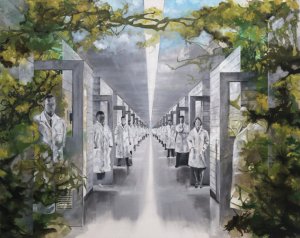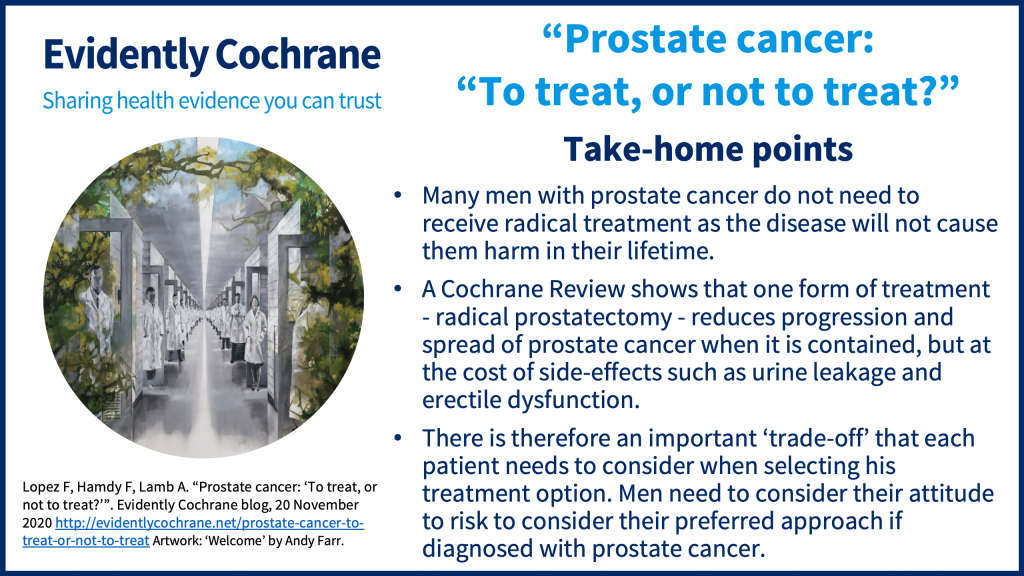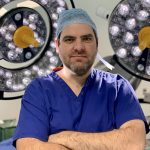In this blog for people making treatment decisions about prostate cancer, surgeons Francisco Lopez, Freddie Hamdy and Alastair Lamb explore the evidence, weigh up the benefits and harms, and suggest some questions that you may wish to discuss with your clinician. Artwork: ‘Challenge and Shelter in a Tough Year’ by Ruth Dalzell*.
Page updated 19 April 2023
Take-home points
Prostate cancer is a very common disease and may affect over half of men who live beyond their 80s. The good thing is that the vast majority of these men will never know they have prostate cancer, and even many of those who do know will not need treatment. There have been several major studies to assess whether men with prostate cancer require treatment or whether their cancer can just be monitored without any active intervention.
When cancer is contained to the prostate and radical treatment is deemed necessary, one of the main options is surgery to remove the whole prostate (radical prostatectomy). In a recent Cochrane Review ‘Radical prostatectomy versus deferred treatment for localised prostate cancer’ (June 2020) Vernooij and colleagues specifically analysed the studies assessing whether surgery made a difference, compared to monitoring alone, in reducing the risk of death and other important consequences of leaving the cancer untreated. But first, let’s consider, why is prostate cancer so different from most other cancers? And why might it not need to be treated?
Which prostate cancers need treating?
The prostate specific antigen (PSA) blood test is used to ‘screen’ for prostate cancer. It is mostly used in ‘opportunistic screening‘ as, to the best of our knowledge, there are no countries that currently offer a formal screening programme for prostate cancer. This has led to an increase in the diagnosis of early-stage cancer, reducing the number of patients diagnosed with advanced disease but detecting a large number of men with insignificant cancers which will not harm them in their lifetime. It is therefore challenging to counsel men who may be concerned about having prostate cancer, and those who already found out they have the disease, and who are considering their options.
We know that there are some localised cancers that can behave aggressively with the ability to grow and spread beyond the prostate. They are deemed intermediate or high-risk depending on the probability of this happening over a man’s lifetime. There is broad consensus that patients with this type of cancer and a good life expectancy should be offered treatment with curative intent to avoid the progression of the disease, with the exception of some intermediate-risk cancers which can be monitored without immediate intervention.
On the other hand, there are cancers which grow so slowly that they seem not to grow at all. There is ample evidence that these cancers do not tend to spread, remaining unchanged for several years, even a lifetime. They are therefore considered low-risk. Men who have low-risk prostate cancer are not likely to benefit from active treatment and are amenable to more conservative strategies since the risks related to treatment are higher than the chances of progression and spread. It is recognised that treating such men can cause more harm than good.
Risk is mainly determined by the clinical picture, PSA level, imaging and findings on prostate biopsy, as well as the presence of competing health problems, which can be more serious than the cancer itself. It is also known that in a few men with a strong family history of prostate and breast cancer, and genetic abnormalities such as mutations in the genes responsible for breast cancer in women (BRCA-1 and BRCA-2), the disease is likely to be aggressive. These genetic changes tend to run in families and can be suspected and tested for easily if necessary. Of all known risk factors, grading of the cancer, i.e. the way that it looks under the microscope after biopsy – otherwise known as Gleason score, is the strongest. However, biopsies can only show the characteristics in the areas that were sampled, and zones with more aggressive cancer might be missed. This is called ‘misclassification’. Although there are strategies to reduce misclassification, such as the use of pre-biopsy imaging in the form of multiparametric MRI targeted and confirmatory biopsies, reducing the number of misclassified patients remains a challenge in the current diagnostic pathway.

Monitoring: Active Surveillance and Watchful Waiting
For young patients with low-risk disease, “active surveillance” (also known as “active monitoring”) has been developed. The rationale is that, for such patients, the risks of progression are low. Consequently, treatment is not necessary or beneficial and could be even harmful. An active monitoring program with close follow up including regular repeat PSA, MRI scans and repeat biopsies as necessary enables at least half of these men to avoid treatment completely.
Older patients with shorter life expectancy and other health problems can, instead, be considered for “watchful waiting”. This approach takes into account the slowly progressive nature of the disease, even when high risk, and acknowledges competing health problems where the patient may die of other causes before prostate cancer becomes a problem. Again, providing treatment would be more harmful than beneficial for them and could be avoided. In watchful waiting, follow-up is more reactive than ‘active surveillance’, the intention being to act in response to signs of spread rather than actively looking for any change in the disease.

Surgery vs Monitoring: What is the evidence?
It is important to emphasise that surgery or radiotherapy are the main options to treat patients in the higher-risk groups for whom treatment with curative intent is thought to be beneficial. They are both equivalent in controlling cancer, but have essential differences in terms of how the treatment is delivered and the possible side effects.
In their review, the authors looked at the evidence of benefit versus harm when surgery is compared with deferred treatment for localised prostate cancer. The researchers analysed four well-known studies, three of which assessed surgery versus watchful waiting which took place in the US and Scandinavia – SPCG-4, PIVOT, and VACURG – and one looking at radical treatments including surgery and radiotherapy versus active monitoring – ProtecT (see also Donovan et al). The three watchful waiting trials were pooled, giving 1537 patients while ProtecT was included separately (1098 patients), excluding the men who received radiotherapy. They concluded that radical prostatectomy results in improved cancer outcomes in men with localised prostate cancer. Specifically, all three studies showed a reduction in risk of progression and metastasis (disease spread) after prolonged follow-up of many years, while two studies showed a reduction in deaths from prostate cancer. All studies showed that surgery causes different degrees of urine leakage and difficulties with getting spontaneous erections which affected sexual function.
Importantly, we have to take into account that these studies took place at different periods between 1967 and 2009, over 40 years, during which prostate cancer management has changed significantly. For instance: 1) PSA was not available for the first trial (VACURG), and few men were receiving PSA testing in SPCG-4; 2) none of the trials used imaging before biopsy, which is now known to reduce the detection of insignificant prostate cancers; and 3] the classification of cancers detected according to risk using grading was less refined, and it was not clear that ‘low-risk’ men did not require treatment.
Shared decision making
After diagnosis, patients with prostate cancer face a dilemma regarding the selection of treatment. The decision is always made after careful counselling by health professionals, who present the advantages and disadvantages of each treatment option, the associated risks and possible side-effects. In many ways, this decision-making process is based on attitude to risk, where possible harms related to a condition are weighed against the benefits and side effects of treatment. Different individuals will inevitably give different weighting to each factor according to their personal preferences and beliefs, in discussion with their partner and family.
Currently, the consensus in clinical practice globally, is that men with low-risk prostate cancer should be offered active surveillance as the first treatment choice. In the UK, NICE guidelines recommend that these patients are offered equally the choice between active surveillance, radical prostatectomy or radical radiotherapy and that men with intermediate-risk disease should also be given the option of selecting active surveillance if they do not choose to have radical treatment. Similarly, European guidelines, suggest that these treatments can be offered in the low-risk setting “as alternatives to active surveillance to patients suitable for such treatments and who accept a trade-off between toxicity and prevention of disease progression”. After proper counselling, most patients with low-risk disease undergo active surveillance. Few choose radical treatment, possibly because of the anxiety of living with a cancer diagnosis, but mainly because of inadequate counselling. Perhaps it would be better for such men not to have had their cancer detected in the first place to avoid over-treatment with subsequent unnecessary side effects.
During the COVID-19 pandemic, and since national lockdown in the UK on 23rd March 2020, fewer men have undergone PSA testing, with one study showing a reduction in testing of up to 83%. While it has been argued strongly that cancer patients in general could have suffered poorer outcomes than in normal times because of the mobilisation of health resources, reduced attendance for medical advice and fear of the spread of the virus, it is unclear whether this holds true for prostate cancer. There is the possibility that many will have benefited from a reduction in over-detection and over-treatment, or perhaps we will witness a surge of advanced and metastatic prostate cancer as normal services resume. Irrespective of the epidemiological findings in months and years to come, prostate cancer remains a highly ubiquitous disease with continuing challenges in its management for clinicians and patients alike.
Making decisions about treatment
Commonly asked questions by patients with prostate cancer and their partners:
- How bad is my cancer? Is it contained?
- Do I need to receive active treatment? Am I suitable for active surveillance?
- If I chose active surveillance, what is the risk of the disease progressing over time? Will the cancer kill me?
- If I chose radical treatment, which is the best to reduce harm from the disease?
- What are the possible side effects of each treatment option? Will I recover from these side effects?
- How do I know that the treatment has worked?
- How will I know if the disease has come back? And what additional treatments are available?
You might also find it helpful to look at Making health decisions: things that can help.
Editor’s update: new evidence on radiotherapy for prostate cancer
A new Cochrane Review on Dose‐escalated radiotherapy for curative treatment in men with clinically localized prostate cancer was published in March 2023. It explores how a higher radiation dose compares to a lower dose when treating prostate cancer that is limited to the prostate gland.
The review finds that, compared to a lower dose, a higher radiation dose probably has little to no effect on the risk of dying of prostate cancer, or severe bowel or urinary‐related unwanted effects in the long term, or on physical health. It may have little to no effect on mental health either.
Managing urinary incontinence after prostate surgery
The authors of a new Cochrane Review Conservative interventions for managing urinary incontinence after prostate surgery (April 2023) have concluded that the benefits of non-drug and non-surgical treatments, and any unwanted effects of those treatments, remain uncertain.


*Artwork by Ruth Dalzell: ‘Challenge and Shelter in a Tough Year’ is part of is part of the Breast Cancer Art Project. Ruth said “This is symbolic of the year my husband and I were both diagnosed with cancer (2015- him prostate and me breast cancer). I painted it as a picture of my husband in a familiar place near our home and originally had him walking away but halfway through painting I had a strong feeling that I needed him to be walking towards me. The dark trees on the right symbolise the threatening nature of the experiences of being diagnosed and undergoing unpleasant treatment. The green canopy of willow trees is protective and comforting with the sun glistening through providing a feeling of hope for the future.”
Featured image: ‘Welcome’ by Andy Farr / @andyfarrart.
Join in the conversation on Twitter with @uro_lopez, @Freddie_Hamdy, @LambAlastair, @CochraneUK or leave a message on the blog.
Please note, we cannot give medical advice and we will not publish comments that link to commercial sites or appear to endorse commercial products. We welcome diverse views and encourage discussion. However we ask that comments are respectful and reserve the right not to publish comments we consider offensive.
Francisco López and Alastair Lamb have nothing to disclose.
Dr. Hamdy reports grants from HTA NIHR, during the conduct of the study; personal fees from Intuitive Surgical UK Policy Advisory Board, outside the submitted work; and Editor-in-Chief, British Journal of Urology International.
Read the rest of the blogs in the “Contemplating Cancer” series:
- Informal caregivers: the invisible people caring for cancer survivors by Beverley Lim Høeg and Pernille Envold Bidstrup
- Communicating about cancer: experiences and reflections by Sarah Chapman
- Cancer and Post-Traumatic Stress by Sally Crowe
- Communication with cancer patients: does practice make perfect? by Charlotte Squires
- Does communication skills training improve cancer care? by Liz O’Riordan
- Contemplating Cancer: a special series from Cochrane UK by Sarah Chapman



